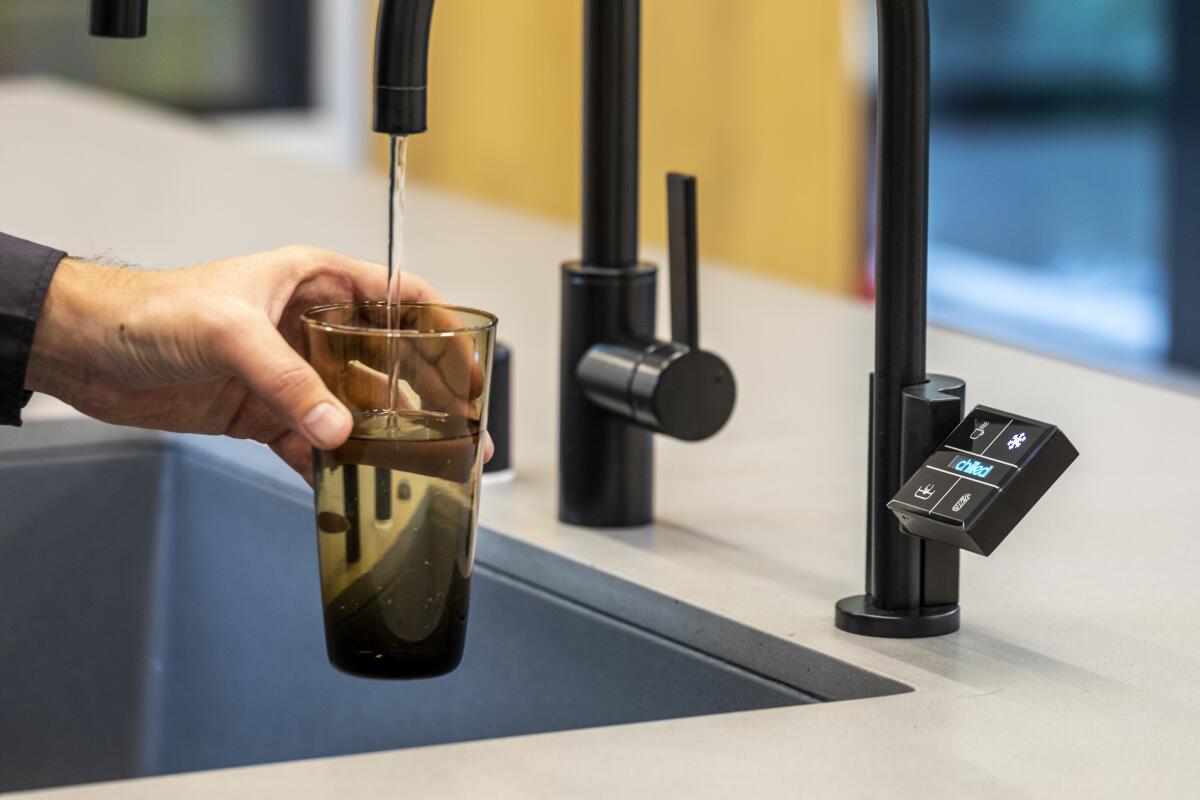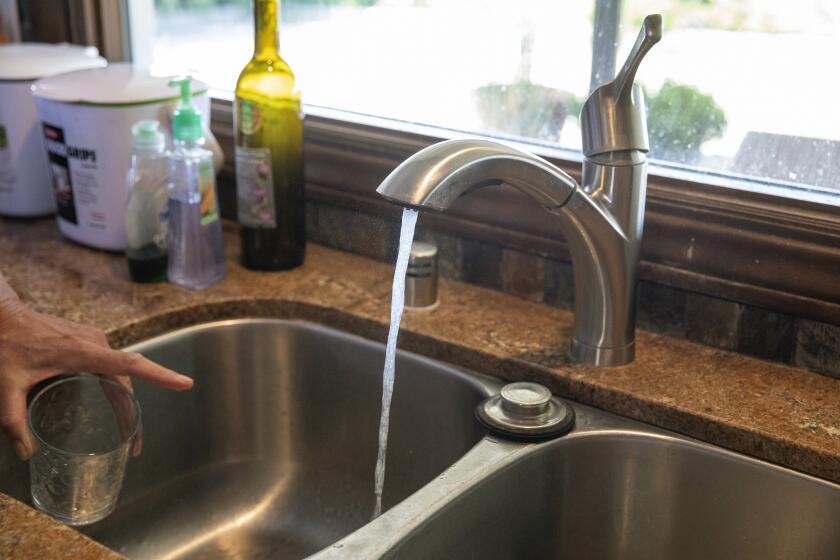Is your water or power being shut off? You have options

- Share via
Every month, millions of low-income Californians struggle to pay their water and utility bills.
A survey on COVID-19‘s financial effect on water systems and customers found that 12% of California households were behind on their water bills, and that statewide, customers owe $1 billion in water debt. The debt was most acute in Southern California, where ZIP Codes in Los Angeles, Colton, Bell Gardens, Norwalk and Cypress had among the highest amounts.
Yet even before the pandemic, many Angelenos struggled to keep up with utilities. In February 2020, Los Angeles Department of Water and Power customers owed $85.6 million in utility debt, according to a recent report by RePower LA, a coalition of organizations advocating for a more equitable DWP. As of August, DWP customers had $226.9 million in arrears “with no shutoff moratorium and no explicit shutoff protections in place,” the report said. It also found that shut-offs were based on the entire DWP bill, even if customers were enrolled in arrears or an assistance program for some services.
The DWP is the water and electricity utility for the city of Los Angeles. Other cities in L.A. County and beyond have public or private utilities that provide water, electricity, trash and other services. If you don’t know who your utility providers are, look at your water, power or gas bills — or consult the L.A. County Public Works service locator.
Last month, the state announced that it distributed $1.4 billion to support more than 2 million households during the pandemic, adding that it will distribute another $1.4 billion by the end of the year through utility assistance programs to cover Californians’ utility debt.
So if you’re behind on your water bill, state law (the Water Shutoff Protection Act) prohibits most water companies from shutting off your water unless your payment is overdue by 60 days. Water utilities are also required to notify you at least seven business days before a shut-off, and they must have their shut-off policy on their website. (DWP’s policies can be found on its website: Click on “Residential Customers,” then “Customer Service,” and on the lefthand side at the bottom of the page, click “Water Service Disconnection Policy.” You can download the complete policy in six languages.)
“California law requires most utility and water providers to work with you to keep your lights on and tap flowing,” Atty. Gen. Rob Bonta said in a news release last month. “I urge Californians to familiarize themselves with their rights, and to get help if they are facing a utility or water shutoff.”
The Water Rate Assistance Program, which Gov. Gavin Newsom vetoed last month, would have created a water affordability program for low-income households.
What can I do if I’m behind on water payments?
The available assistance can depend on your income. If it’s less than 200% of the federal poverty level, or if you receive benefits such as CalFresh, Medi-Cal or a Supplemental Security Income, your water provider is required to waive the interest charges you owe every 12 months. To find out what you may qualify for, utility providers like DWP have financial assistance qualification forms you can complete online.
There’s also the Low Income Household Water Assistance Program, a one-time financial aid to help you pay overdue water and wastewater bills. But emphasis on “one time.” You can receive the benefit only once, and the program is set to end in August 2023. As Kelsey Hinton from the Community Water Center previously told me: Even if your “debt gets wiped out today, there’s nothing available to keep you from accruing more debt in the future.”
Also, not all water and wastewater services offer assistance through the program. Contact your water provider to find out whether they participate and how to apply.
Another option is a payment plan, which most water providers must make available. Check your provider’s website or call to inquire.
The Los Angeles Department of Water and Power has launched two new programs to help lower-income Angelenos stay cooler and not get burned by peak summer electric bills.
What can I do if I’m behind on other utility bills?
Through the California Alternate Rates for Energy or the Family Electric Rate Assistance programs, you could be eligible for discounts on your gas and electric bills depending on your income and if you get utilities from a private company. If your provider is a government agency, call the number on your bill or visit its website to learn about discounts for low-income households. Also ask about payment plan options. One way to find out if your provider is a private company or government agency is to visit the California Public Utilities Commission’s website, which regulates privately owned utility companies. It lists entities it does not oversee, including municipal utilities.
Like private water companies, private utility providers must offer a payment plan to give you more time to pay your bill. “Your power cannot be shut off once you agree to a payment plan, and must remain on if you are making timely payments,” Bonta said in the release.
If you require constant power for medical equipment and getting your electricity shut off is life threatening, you may have more options. Immediately contact your provider, which may schedule an in-person visit to try to resolve the situation.
And if you believe your water and utility provider is not complying with the law, you can file a complaint through the California Department of Justice‘s website.
The Water Rate Assistance Program, which Gov. Gavin Newsom vetoed last month, would have created a water affordability program for low-income households.
Why this matters
Water and other utility debts are a monthly stressor felt unequally among families.
The RePower LA report found that Black, Latino and low-income households across L.A. bear the brunt of utility shut-offs. Between 2017 and 2020, more than 77,400 residential customers had their water or power disconnected at least once, with Black and Latino communities nearly 2½
and two times more likely, respectively, to experience shut-offs than majority white neighborhoods. Of those, 1 in 5 residents never got their water or power reconnected.
Shut-offs were also longer in low-income and communities of color. Customers with an annual income of less than $50,000 had an average shut-off duration of 22.3 hours, compared with customers who made from $100,000 to $150,000; their average duration was 6.2 hours.
“Water and power are essential to life,” said Alicia Morales Perez, research and policy analyst at the Los Angeles Alliance for a New Economy, or LAANE, and a co-author of the report. “So not having access to water and power creates harmful and dangerous conditions to families and even leads to trade-offs — having to choose between paying the rent, covering the food, paying their utility or for transportation.”
The report also found that shut-off moratoriums reduced COVID-19 infections and mortality rates. And as climate change produces longer and worsening heatwaves, policies to stop shut-offs are more critical than ever, said Victor Sanchez, RePower LA director and project director for LAANE.
“Being in an environment that’s 80-plus degrees for a prolonged period of time, it’s a life-threatening situation if you don’t have access to air conditioning,” he said. “We’re going to have more and more of these weather-related emergencies — it’s why it’s important that people don’t get cut off to electricity or to water when these things occur.”
About The Times Utility Journalism Team
This article is from The Times’ Utility Journalism Team. Our mission is to be essential to the lives of Southern Californians by publishing information that solves problems, answers questions and helps with decision making. We serve audiences in and around Los Angeles — including current Times subscribers and diverse communities that haven’t historically had their needs met by our coverage.
How can we be useful to you and your community? Email utility (at) latimes.com or one of our journalists: Matt Ballinger, Jon Healey, Ada Tseng, Jessica Roy and Karen Garcia.
More to Read
Sign up for Essential California
The most important California stories and recommendations in your inbox every morning.
You may occasionally receive promotional content from the Los Angeles Times.
















